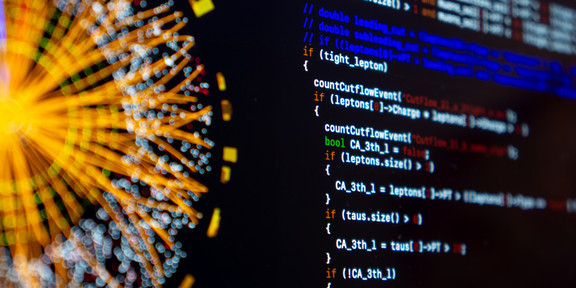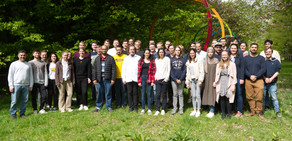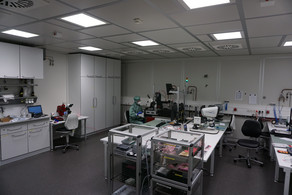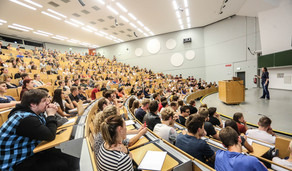Abschlussarbeiten
Sie interessieren sich für eine Abschlussarbeit im Bereich der Teilchenphysik?
Wir bieten jederzeit Themen für Bachelor-, Master- und Doktorarbeiten zu aktuellen Forschungsfragen an. Eine Übersicht der aktuell verfügbaren Themen im Bereich der Teilchenphysik finden Sie unten auf dieser Seite. Auch einen Überblick über die in unserer Gruppe bisher zu diesem Thema angefertigten Abschlussarbeiten finden Sie weiter unten.
Wenn Sie Interesse an einem der aktuell verfügbaren Themen haben, oder wenn Sie gerne weitere Möglichkeiten und Themen aus dem Bereich der Teilchenphysik besprechen möchten, kontaktieren Sie uns gerne. Wir freuen uns auf ein persönliches Gespräch mit Ihnen.

Kontakt
Aktuell verfügbare Themen für Abschlussarbeiten
Verletzt das Higgs-Boson die Bell-Ungleichungen?
- Abschlussarbeitsthemen
- Teilchenphysik

Hintergrund:
Die Bell’schen Ungleichungen bilden einen zentralen theoretischen Rahmen, um grundlegende Annahmen der Physik wie Lokalität und die Zufälligkeit der Quantenmechanik zu prüfen. Sie quantifizieren den Grad der Verschränkung in Quantensystemen und wurden bisher überwiegend an Niedrig-Energie-Systemen getestet, da Verschränkung in ultrakalten Umgebungen leichter erzeugt und aufrechterhalten werden kann.
Auch in Hochenergie-Quantensystemen, wie sie am LHC erzeugt werden, gibt es jedoch Möglichkeiten, die Bell-Ungleichungen zu testen. Das Higgs-Boson als Spin-0-Teilchen zerfällt in ein Paar von W-Bosonen, die verschränkt sein können. Die Analyse der Bell-Variablen in diesem System bietet die Möglichkeit, die Bell-Ungleichungen erstmals bei hohen Energien zu untersuchen.
Ziel der Arbeit:
Die Entwicklung einer neuen Methode zur Berechnung von Bell-Variablen aus den Zerfallsprodukten des Higgs-Bosons:
- Rekonstruktion: Anwendung und Weiterentwicklung bestehender Rekonstruktionsansätze für die kinematischen Eigenschaften der W-Bosonen.
- Neue Analysestrategie: Einsatz von Machine-Learning-Techniken, insbesondere denoising diffusion networks, um die entanglement-relevanten Variablen präzise zu rekonstruieren.
- Machbarkeitsstudie: Überprüfung der Methode auf realen oder simulierten Daten aus Higgs-Zerfällen, um die Verletzung der Bell-Ungleichungen zu verifizieren.
Langfristiger Nutzen:
Dieses Projekt könnte die Forschung zu fundamentalen Quantenmechanik-Konzepten auf völlig neue Weise erweitern. Es bietet die Möglichkeit, Nobelpreis-ausgezeichnete Forschung am LHC weiterzuentwickeln und auf Hochenergie-Systeme anzuwenden.
Wünschenswerte Voraussetzungen:
- Interesse an Quantenmechanik, Statistik und Hochenergiephysik.
- Grundkenntnisse in Machine Learning und Programmierung (Python, ROOT).
- Motivation, innovative und komplexe Methoden zu entwickeln und anzuwenden.
Kontakt
Abgeschlossene Abschlussarbeiten
Dissertationen
Masterarbeiten
| Giulia Fazzino | Suppressing pile-up contributions in the formation of topological clusters in ATLAS | September 2024 |
| Jan Jaekel | Jet-Lepton Overlap Removal Optimization in context of the boosted H to WW to lnuqq measurement using Run 2 data in ATLAS | April 2024 |
| Simone Ruscelli | Feasibility studies for the extraction of the efficiency of boosted W/Z identification algorithms in diboson events using 13 TeV proton-proton collisions in ATLAS | September 2023 |
| Donna Maria Mattern | Measurement of the top-quark pair to Z-boson production cross-section ratio at a centre-of-mass energy of √s = 13.6 TeV with the ATLAS detector | April 2023 |
| Simon Neuhaus | Studies for the measurement of the production of top-quark pairs in association with a Z boson decaying to a pair of tau leptons with the ATLAS detector | Oktober 2022 |
| Lucas Cremer | Sensitivity studies of the interference between FCNC and SM processes | Oktober 2022 |
| Daniel Wall | Studies of radiative top quark processes with Bayesian neural networks | Oktober 2022 |
| Michael Windau | Studies for a graph-based deep-learning method to improve isolation variables for photon identification with the ATLAS detector | April 2022 |
| Aaron van der Graaf | A super-resolution GAN for photon identification at collider experiments | Oktober 2021 |
| Lars Kolk | Systematic-aware top-quark pair reconstruction with deep learning | September 2021 |
| Jan Lukas Späh | Data-driven corrections to shower shape variables for photon identification at the ATLAS experiment | September 2021 |
| Florian Mausolf | Search for flavour-changing photon interactions in top-quark production and decay at the ATLAS experiment using deep neural networks | Mai 2021 |
| Lars Röhrig | Estimating fake-lepton contributions in the framework of Bayesian statistics | Mai 2021 |
| Benedikt Gocke | Search for flavour-changing photon interactions in top-quark production and decay with the ATLAS experiment | Oktober 2020 |
| Alexander Froch | Parton Shower Simulations with Generative Adversarial Networks | Oktober 2020 |
| Patrick Schmidt | Autoencoder for Anomaly Detection in tt-Events | Oktober 2020 |
| Nils Julius Abicht | Study of convolutional neural networks for strange-tagging based on jet images from calorimeters | September 2020 |
| Egor Evsenin-Gutschank | Development of a calibration strategy for the first strange tagger with the ATLAS detector at √s=13 TeV using full Run-2 data | September 2019 |
| Abdulkärim Frempong | Studies for the search for pair produced scalar leptoquarks in proton-proton collisions decaying into top quarks and electrons or muons with the ATLAS detector at √s = 13 TeV | Januar 2019 |
| Björn Wendland | First search for the single production of vector-like B quarks in the B → bH (→ γγ) decay channel using data corresponding to 79.8 fb-1taken with the ATLAS detector at √s = 13 TeV | Oktober 2018 |
| Marius Nagel | Optimization of the Photon Identification at the ATLAS Experiment Using an Adversarially Trained Neural Network | September 2018 |
| Salvatore La Cagnina | Studies of interference effects in processes with flavor-changing neutral currents including a tqγ coupling at the LHC | September 2018 |
| Tim Kallage | Studies on the Reconstruction of Top-Quark Pairs Decaying in the Lepton+Jets Channel with Artificial Neural Networks | September 2018 |
| Stella Oppermann | Development of an Event Selection Based on Machine Learning to Improve ttbar Reconstruction with the KLFitter Algorithm at the ATLAS Experiment | September 2018 |
| Cornelius Grunwald | Constraining dimension-six effective operators through the combination of top quark measurements using EFTfitter | Dezember 2017 |
| Frederic Schröder | Studies on the first search for single production of vector-like B-quarks with B->bH in the H->gamma gamma channel at sqrt(s)=13 TeV with the ATLAS detector | September 2017 |
| Volker Austrup | Search for Single Vector-like Top Partners in the decay channel T->T(nunu)t(qqb) with sqrt(s)=13 TeV at the ATLAS experiment | September 2017 |
| Lennart Rustige | Studies for the background estimation to the search for FCNCs in single top quark + photon production with the ATLAS experiment at √s=13 TeV | Februar 2017 |
| Elena Freundlich | Studies for the Search for Pair Production of Vector-like Quarks in the Dilepton Channel QQ->Z(ll)q+X at √s=13 TeV with the ATLAS Experiment | Oktober 2016 |
| Sonja Bartkowski | Development of a Search for Single Vector-Like Top Partners and Resonant Monotop Production with Boosted Top Quarks and ETmiss in pp Collisions with √s=13 TeV at the ATLAS Experiment | Oktober 2016 |
| Kevin Nolte | Classification with case weights for Top Tagging | August 2016 |
| Tobias Nickel | Comparison of the performance of the KLFitter algorithm at √s = 8 TeV and 13 TeV with the ATLAS detector using the ttbar-lepton+jets decay channel | März 2016 |
| Isabel Nitsche | Studies on the prospect for the search for tH-production with H→γγ at √s=13 TeV with the ATLAS detector | September 2015 |
| Tobias Kupfer | Studies on Substructure based Top Tagging for high pT Jets using Multivariate Techniques at √s=14 TeV with the ATLAS Detector | September 2015 |
| Gregor Geßner | Measurement of the top quark mass in final states with three jets and one charged lepton at √s=8 TeV with the ATLAS experiment | September 2015 |
| Lennart Behrendt | Optimierung der Performance von Algorithmen zur Identifikation von B-Jets auf Basis multivariater Methoden | September 2015 |
Bachelorarbeiten
| Frederik Johannes Zielke | Characterization and manipulation of an anion beam for spectroscopy and trapping with the Borealis experiment | Juli 2024 |
| Lennart Völz | Facilitating Bell inequality measurements in entangled H -> WW -> lvlv systems using machine learning techniques with the ATLAS experiment | Juli 2024 |
| Max Möller | Interpretations of fiducial differential cross- section measurements of gluon fusion Higgs production in H->WW->lvlv decays in terms of a Standard Model Effective Field Theory with the ATLAS Experiment | Juli 2024 |
| Joel Koch | Quark versus gluon tagging in the forward direction using topo-towers with the ATLAS detector | August 2023 |
| Bastian Schuchardt | Achievable performance of boosted object identification algorithms using machine learning techniques in ATLAS | Juli 2023 |
| Simon Unterste- Wilms | Performance of boosted object identification in fast simulation at the ATLAS Experiment | März 2023 |
| Chiara Deponte | Studies on the properties of non-prompt photons at the ATLAS experiment, Bachelorarbeit | Juli 2022 |
| Marina Andress | Studien zu den Aussichten der direkten Messung des CKM-Matrixelements Vtd mit tW Ereignissen am ATLAS Experiment | Juli 2022 |
| Niklas Düser | Studies to optimize the neural network input features for the search of same-sign top-quark production | Juni 2022 |
| Lukas Riedel | Studies on using distance correlation for the estimation of jet background in photon identification at the ATLAS experiment | Januar 2022 |
| Cihad Gözsüz | Neural network based signal-background classification for the differential single top+photon measurement at the ATLAS experiment | Juli 2021 |
| Lisa Goldschmidtböing | Training Neural Networks on ATLAS Open Data to Separate Signal and Background of Single Top Quark Production in pp Collisions at 13 TeV | November 2020 |
| Andrej Kusurmann | Fake lepton estimation in top quark processes with one electron or muon in the final state | Oktober 2020 |
| Judith Gnade | Energy Conservation in Generative Adversarial Networks for Parton Shower Simulations | September 2020 |
| Daniel Wall | Optimisation Studies for the Direct Measurement of the Top-Quark Decay Width using TATORTCleaner at the ATLAS Experiment | August 2020 |
| Lucas Cremer | Untersuchung der Sensitivität von Messungen des differentiellen Wirkungsquerschnitts von Top-Paar-Produktion in Regionen hohen transversalen Impulses auf Dimension-Sechs-Operatoren am LHC | August 2020 |
| Simon Nicklas Neuhaus | Sensitivitätsstudien für den Zerfall H → ss am LHC | August 2020 |
| Donna Mattern | Testing profile-likelihood unfolding in top-quark measurements with the ATLAS experiment | August 2020 |
| Cyrus Walther | Discrimination of Standard Model and EFT contributions in single top production with a photon | Juni 2020 |
| Marcel Moczarski | Neural network studies for the search for flavour-changing tqy interactions with the ATLAS detector | Juni 2020 |
| Nils Breer | Studien zur Verbesserung von Strange-Tagging in pp-Kollisionen durch die Rekonstruktion von Λ-Baronen | August 2019 |
| Jonah Blank | Studies on event selection criteria for the non-resonant HH->bbbb decay channel | August 2019 |
| Nicole Schulte | Study on the sensitivity of top quark spin correlations to supersymmetric top quark partners | August 2019 |
| Saskia Kahl | Studien zur Verbesserung der Suchsensitivität nach einzeln produzierten Vector-like-Top-Quarks mit der Matrix-Element-Methode am ATLAS-Detektor | Juli 2019 |
| Lars Kolk | Studies for a multi-class boosted object tagger at the ATLAS experiment | Juli 2019 |
| Aaron van der Graaf | Studien zur Bestimmung von |Vts| in dileptonischen tt Zerfällen unter Berücksichtigung von rekonstruierten KS und Λ0 | Juli 2019 |
| Jan Lukas Späh | Studies for the sensitivity to dimension six operators in the context of effective field theories in singe-top-quark production with a photon | Juli 2019 |
| Michael Windau | Studien über die Auswirkungen verschiedener b-Tagging-Arbeitspunkte auf die Performance eines Algorithmus zur Verbesserung der tt-Rekonstruktion am ATLAS-Experiment | Juli 2019 |
| Philipp Hellmann | Aufbau einer Messanordnung zur Überprüfung der Szintillationseigenschaften von Polyethlennaphthalat | September 2018 |
| Janina Nicolini | Kombination und EFT-Interpretation von Messungen des ttγ Produktionswirkungsquerschnitts in Proton-Proton-Kollisionen | Juli 2018 |
| Benedikt Gocke | Suche nach einzeln produzierten Vector-like Top-Quarks am ATLAS Detektor mit der Matrix Element Methode | Juli 2018 |
| Patrick Schmidt | Studien zur Optimierung der Photon-Isolation für die Suche nach einzelproduzierten vektorartigen B-Quarks im Zerfallskanal B → H(→ γγ)b am ATLAS-Detektor bei √s = 13 TeV | Juli 2018 |
| Dominik Hellmann | Decay kinematics comparison of pair-produced leptoquarks and vector-like quarks in proton proton collisions at √s = 13 TeV at the LHC | Juli 2018 |
| Alexander Froch | Signal and Background Discrimination for the Search of Single Vector-Like-Top-Quark Production at the ATLAS Detector with Artificial Neural Networks | Juli 2018 |
| Andre Augustin | Studies on top tagging for intermediately boosted top quarks using machine learning with the ATLAS detector | April 2018 |
| Tobias Decking | Studien zur Suche nach vektorartigen B-Quarks mit Hilfe von multivariaten Methoden und dem ATLAS-Detektor am LHC bei √s = 13 TeV | August 2017 |
| Nils Julius Abicht | First studies on the distinction of strange and bottom jets with the ATLAS detector in Run 2 | Juli 2017 |
| Egor Evsenin-Gutschank | Studies of the Impact of the Isolation Criteria for the Measurements of Photon Identification Efficiencies with the ATLAS Detector at √s = 13 TeV | August 2016 |
| Salvatore La Cagnina | Constraints on the top quark width from cross section and branching ratio measurements using EFTfitter | Juli 2016 |
| Philip Boenke | Studies for the improvement of the uncertainty on measurements of the top-tagging efficiency in ttbar events at the ATLAS experiment | Juli 2016 |
| Abdulkärim Frempong | Study of the mass dependent optimisation of the event selection for the single production Y → Wb vector-like quark search with one lepton in the final state with the ATLAS detector at √s = 13 TeV | Juli 2016 |
| Valerie Hohm | Optimisation Studies for the Search for tH Production at the ATLAS Experiment with first √s = 13 TeV Monte Carlo Samples | Juli 2016 |
| Tim Kallage | Performance Studies on the Reconstruction of Vector-Like Top Quark Pairs Decaying in the Channel TT → ZtWb with the KLFitter Algorithm at the ATLAS Experiment | Juli 2016 |
| Simon Mahn | Optimierung der Untergrund-Unterdrückung bei der Suche nach Vector-Like-T-Quarks mit dem ATLAS-Detektor | Juli 2016 |
| Marius Nagel | Jet Cleaning Studies for Monotop Topologies at the ATLAS Detector at √s = 13 TeV | Juli 2016 |
| Stella Oppermann | Optimization Studies for the Boosted Event Selection in a Search for Vector-Like Quark Pair Production in the Channels TT→WbZt and BB→WtZb with the ATLAS Experiment | Juli 2016 |
| Björn Wendland | KLFitter studies for semi-boosted ttbar events with the ATLAS detector at √s = 13 TeV | Juli 2016 |
| Frederic Schröder | Studien zur Identifikation geboosteter Top-Quarks mit Substrukturvariablen kombiniert in einem künstlichen neuronalen Netz | Juli 2015 |
| Sonja Bartkowski | Suppression of QCD-Multijet Background Using Multivariable Classification Methods | August 2014 |
| Tobias Kupfer | Analyse der √s=7 TeV ATLAS-Daten aus 2011 zur Verbesserung der W+Jets-Untergrund-Bestimmung zur Messung der Masse des Top-Quarks | Oktober 2013 |
| Isabel Nitsche | Optimization of the signal-background separation in the single-top t-channel at the ATLAS experiment using neural networks | Oktober 2013 |
| Gregor Geßner | Systematic study about phase space separated b-tagging at the ATLAS experiment | Juli 2013 |





